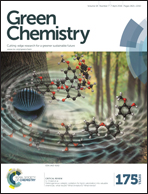Environmentally-safe and transparent superhydrophobic coatings†
Abstract
The bioinspired field of superhydrophobicity has almost universally deployed environmentally-detrimental approaches relying on organic solvents and fluorinated compounds to generate liquid-repellent surfaces, thus severely limiting application at industrial scales. Recent water-borne methods have reduced the use of volatile organic compounds, but these methods often rely on either fluorinated chemistries (to lower surface energy) or charge-stabilization (to suspend roughness-enhancing particle fillers). An entirely water-based and fluorine-free superhydrophobic formulation has been developed from hydrophilic titanium dioxide (TiO2) nanoparticles and polyolefin copolymers, without additional surfactants or charge-stabilization. The commercially-available ingredients are combined in a single-step, substrate-independent, wet-process application to deliver an ultra-simple, semitransparent coating which is attractive for large-area, fluid-barrier surface treatments. The coating constituents are environmentally-safe and FDA-approved, overcoming a nontrivial hurdle in the scalable development of sustainable fluid management technologies.


 Please wait while we load your content...
Please wait while we load your content...